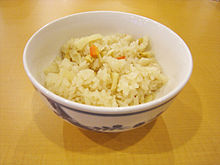Takikomi gohan

Takikomi gohan (
History[edit]
Takikomi gohan was created during the Nara period.[4] Rice was scarce then, so people conserved rice by adding millet or other cereals, wild vegetables, yam or Japanese radish, creating an early form of takikomi gohan called katemeshi.[4] During the Muromachi period, katemeshi became popular, turned into a dish called kawarimeshi using ingredients such as barley, beans, and vegetables. Over time people became creative and made a variety of dishes with seasonal ingredients.[4]
Difference from maze gohan[edit]
Takikomi gohan is prepared by adding the ingredients, broth and seasonings to raw rice and cook them together. In contrast, maze gohan (
Variations[edit]
- Tai-meshi (
鯛 飯 ): Rice with whole sea bream.[6]: 277 - Ayu-meshi (
鮎 飯 ): Rice with whole sweetfish. - Matsutake gohan (
松茸 御飯 ): Rice with matsutake mushrooms. - Kani-meshi (
蟹 飯 ): Rice with crab. - Gomoku meshi (
五目飯 ) 'five ingredients rice' (or gomoku gohan (五目 御飯 )): Combination of ingredients such as shiitake mushrooms, bamboo shoots, burdock root, carrots, konnyaku, chicken,[7][6] or white-fleshed fish. In the Osaka dialect, this dish is called kayaku gohan (加薬 御飯 ).[6] - Kamameshi (
釜飯 ): Takikomi gohan cooked and served in a single-serving pot.[8] - Kuri gohan (
栗 ご飯 ): Rice with chestnuts.[9] - Kufa jūshī (クファジューシー): Okinawan cuisine of rice with pork.[10]
- KFC rice: Rice with fried chicken.
See also[edit]
- Arroz con pollo, Arroz con gandules, Platillo Moros y Cristianos, Gallo pinto, Pabellón criollo, Rice and beans (Latin America)
- Biryani (South Asia)
- Fried rice (East Asia)
- Jambalaya (Louisiana)
- Jollof rice (West Africa)
- Hoppin' John (Southern United States)
- Kabsa (Saudi Arabia)
- Kedgeree (United Kingdom)
- Kushari (Egypt)
- Nasi goreng (Indonesia)
- Paella (Spain)
- Pilaf (Greece, Balkans, Turkey, Iran, Central Asia, South Asia)
- Rice and peas (Caribbean)
- Risotto (Italy)
- Spanish rice (Mexico)
References[edit]
- ^ "Taste of Japan – Takikomi-gohan (Soy sauce flavored rice cooked with chicken and mushrooms)". Ministry of Agriculture, Forestry and Fisheries (Japan). Archived from the original on 2022-08-13. Retrieved 2022-11-04.
- ^
9月 に美味 しい旬 の野菜 . (n.d.). Retrieved November 05, 2020, from https://foodslink.jp/syokuzaihyakka/syun/monthly/septembre-ve.htm - ^ Watanabe, A. (2020, October 05).
炊 き込 みご飯 のカロリー・糖 質 は?白米 よりダイエット向 きな理由 は?. Retrieved November 05, 2020, from https://chisou-media.jp/posts/598 - ^ a b c "takikomi gohan" たきこみごはん.
米穀 安定 供給 確保 支援 機構 (Rice Stable Supply Support Organization) (Japan) (in Japanese). Archived from the original on 2004-12-31. Retrieved 2022-11-03. - ^ "Washoku World Challenge 2013 – Japanese cuisine basics". Ministry of Agriculture, Forestry and Fisheries (Japan). Types of Cooked Rice and Features. Archived from the original on 2022-09-29. Retrieved 2022-11-04.
- ^ a b c Tsuji, Shizuo (2006). Japanese Cooking: A Simple Art (Revised ed.). Tokyo, Japan: Kodansha International. pp. 278–279. ISBN 9784770030498.
- ^ Hosking, Richard (1996). "gomoku meshi". A dictionary of Japanese food : ingredients & culture. Tokyo, Japan: Tuttle Publishing. p. 46. ISBN 0804820422.
- ^ "Authentic Japanese Cooking – Kamameshi (Sakura Shrimp and Rice)". NHK. 2015-04-15. Archived from the original on 2021-11-17. Retrieved 2022-11-04.
- ^ Yukimasa, Rika (2016-11-25). "Rika's TOKYO CUISINE Chestnut Rice – Kuri gohan
栗 ご飯 ". NHK. Archived from the original on 2017-04-30. Retrieved 2022-11-04. - ^ "Our Regional Cuisines: kufa jushi, Okinawa Prefecture" うちの
郷土 料理 クファジューシー沖縄 県 . Ministry of Agriculture, Forestry and Fisheries (Japan) (in Japanese). Archived from the original on 2022-04-07. Retrieved 2022-11-04.
